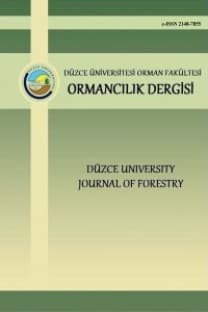Günlük Sediment Yükünün Radyal Temelli Fonksiyon Sinir Ağları Kullanılarak Tahmin Edilmesi
Akarsu Akış, Sediment, Tahmin, RBF
Prediction of Daily Suspended Sediment Load Using Radial Basis Function Neural Networks
Streamflow, Sediment, Prediction, RBF,
___
- Aik, LE and Zainuddin, Z 2008.An Improved Fast Training Algorithm for RBF NetworksUsing Symmetry-Based Fuzzy C-Means Clustering.MATEMATIKA, 24(2), 141–148.
- Bors, A, G 2001. Introduction of the Radial Basis Function (RBF) Networks, Online Symposium for Electronics Engineers, issue 1, vol. 1, DSP Algorithms: Multimedia, pp. 1-7.
- Caroni, E, Singh,V, Pand Ubertini, L 1984. Rainfall-runoff-sediment yield relation by stochastic modeling. Hydrological Sciences Journal, 29:2, 203-218
- Cigizoglu, HK 2002. Suspended Sediment Estimation and Forecasting using Artificial Neural Networks.Turkish J. Eng. Env. Sci.26: 15-25.
- Fahlman, SE 1988.Fast-learning variations on back propagation: an empirical study. In Proceedings of the1988 Connectionist Models Summer School, D.S.
- Fashtali, FJ 2003. Landuse change and Suspended Sediment Yield Analysis Using RS and GIS a case study in Uromieh lake area (Shar-chi Catchment). International Institute For Geo-Information Science and Earth Observation Enschede, The Netherland.
- Haykin, S 2001. Neural Networks: A comprehensive foundation. Macmillan College Publishing.
- Kerr, SJ 1995. Silt, turbidity and suspended sediments in the aquatic environment: an annotated bibliography and literature review. Ontario Ministry of Natural Resources, Southern Region Science & Technology Transfer Unit Technical Report TR-008. 277 pp.
- Kisi, O, Yuksel, I and Dogan E 2008.Modelling daily suspended sediment of rivers in Turkey using several data-driven techniques. Hydrological Sciences Journal, 53:6, 1270-1285
- Knighton, D1998. Fluvial Forms and Processes: A New Perspective, Arnold, London.
- Kisi, O, Yuksel, I and Dogan E 2008.Modelling daily suspended sediment of rivers in Turkey using several data-driven techniques. Hydrological Sciences Journal, 53:6, 1270-1285
- Knighton, D1998. Fluvial Forms and Processes: A New Perspective, Arnold, London.
- Mustafa, MR, Isa, KH and Rezaur, RB 2011. A Comparison of Artificial Neural Networks for Prediction of Suspended Sediment Discharge in River A Case Study in Malaysia. World Academy of Science, Engineering and Technology, 81:372-376.
- NeuroSolution User’s Manual: www.neurosolutions.com Accessed: 07.09.2010
- Orr, M 1996.Introduction to Radial Basis Function Networks. Institute for Adaptive and Neural Computation, Edinburgh Univ.
- Pavelsky, TM and Smith, LC 2009. Remote sensing of suspended sediment concentration, flow velocity, and lake recharge in the Peace-Athabasca Delta, Canada. Water Resources Research, W11417, 45:1-16
- Singh, VP and Krstanovic, PF 1987. A stochastic model for sediment yield using principle of maximum entropy. Water Resources Research, 23:781-793.
- Wang, YM, Traore, S and Kerh, T 2008.Using Artificial Neural Networks for Modeling Suspended Sediment Concentration.10th WSEAS Int. Conf. on Mathematical Methods and Computational Techniques in Eelectrical Engineering (MMACTEE'08), Sofia, Bulgaria.
- Wang, YM, Kerh, T and Traore, S 2009. Neural Networks Approaches for modelling river suspended sediment concentration due to tropical storms. Global Nest Journal, 11: 457-466.
- Wilamowski, BM 2003.“Neural network architectures and learning,” in Proc.ICIT, Maribor, Slovenia, pp. TU1–TU12.
- Zhu, YM, Lu, XX and Zhou, Y 2007.Suspended sediment flux modeling with artificial neural network: Anexample of the Longchuanjiang River in the Upper YangtzeCatchment, China. Geomorphology 84: 111–125.
- ISSN: 2148-7871
- Yayın Aralığı: 2
- Başlangıç: 2005
- Yayıncı: Prof. Dr. Abdurrahim AYDIN
Genç Odun ve Olgun Odunun Lif Morfolojisindeki Farklılıklar Üzerine Bir Araştırma
Nihan ŞENSOY, Aybike Ayfer KARADAĞ
Çeşitli Sentetik Yüzey Kaplamalarının Lif levhanın Isı İletkenliği Üzerine Etkisi
Okul Bahçelerinin Oyun Alanı Olarak Değeri: Düzce Kenti Örneği
Aybike Ayfer KARADAĞ, Serap MUTLU, Şerife SAYIN
Günlük Sediment Yükünün Radyal Temelli Fonksiyon Sinir Ağları Kullanılarak Tahmin Edilmesi
Hızlı Eskitme Testlerinde Emprenyeli Yongalevhaların Bazı Fiziksel Özelliklerinin Değişimi
